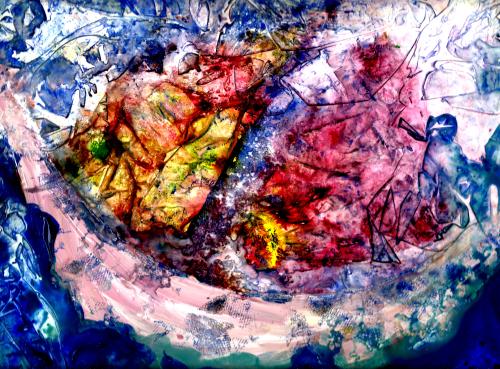
I doubt there is any middle ground with Yupo paper. One either loves it or hates it. The “haters” are those artists who demand control of their paints, and always work with an unflappable agenda in mind. These folks create beautiful works of abject realism, and often artists of palpable realism are highly trained and amazingly gifted—especially if they achieve high end realism in watercolors. Everyone knows that chasing watercolors is a bit like herding cats.
I am neither highly trained nor amazingly gifted, and fortunately the art I love the most does not fall in the category of abject realism. My favorite artists, the French Impressionists, Post Impressionists, Les Fauves, etc. who worked largely in oils were realistic to a degree, but always with an intensely personal voice. For anything other than “personal voice” I would use a camera—and for me, that wouldn’t be half as much fun as getting out the Yupo and letting the paints fly hither and thither.
Last week my good friend and fellow artist, Vikki, and I shared an art day at our dining room table. We began on Yupo. My rendering was, for starters, terribly generic and dreadfully similar to stacks of other paintings I’ve done: tree – space – tree – space; leaves and blossoms on tree – space – etc; and plomp – plomp – plomp – ad nauseum.
Now I detest—and desire to always eschew—the plagiarizing of any thing or any person, including myself. So that night I looked over this Yupo thingy, almost upchucked, sprayed it with my trusty water bottle, pressed plastic clingy food wrap onto the entire surface, and went to bed.
The next day I removed the cling film and VOILÀ! Something I could further develop and live with: the suggestion of a Viking ship* with sails, and lots of turbulence all over the place. So much better than plomp – plomp – plomp!
I added delineation and definition via gouache to the vessel and its surrounding sky and water—leaving a plethora of confusion, color, and turbulence in the sails as if the depicted journey was, like many of life’s journeys, fraught with distractions, dead-ends, and disasters.
However I am always a positive-note person, so then I named the piece: “Heading for Home the Last Time”—reflecting my blessed assurance in a glorious destination through it all, and eternal joy in the presence of my Lord Jesus.
Margaret L. Been, May 2017
*Because this painting is matted and framed to 12″ x 16″, it was too large to entirely fit in my scanner. Thus the ends of the ship do not completely show on the print. The original in its full size is more representative of an actual Viking ship. Since my husband is descended from Vikings, and loves ships, I wanted to be somewhat realistic. 🙂



